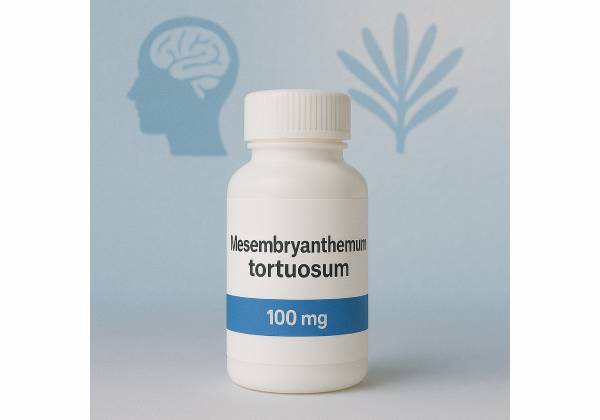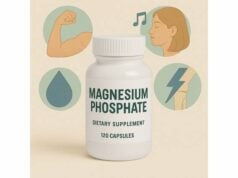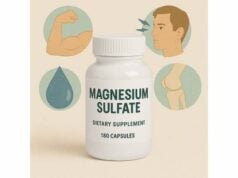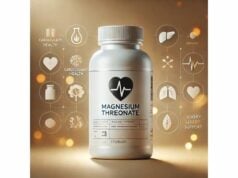
Mesembryanthemum tortuosum—better known today as Sceletium tortuosum or “kanna”—is a South African succulent traditionally chewed or brewed to ease stress and lift mood. Modern standardized extracts concentrate a family of alkaloids (mesembrine, mesembrenone, mesembrenol, mesembranol) that act on serotonin pathways and on phosphodiesterase-4 (PDE4), two targets linked to anxiety, resilience under stress, and cognitive flexibility. Early clinical studies in healthy adults suggest short-term benefits for subjective anxiety, stress responses, and certain executive functions, with generally good tolerability over several weeks to three months. People use kanna in capsules, sublingual tablets, teas, and tinctures; standardized capsules are the easiest way to control dose and avoid variability in raw plant material. While it is not a substitute for professional care, kanna appeals to people seeking a gentler, plant-based option to support everyday calm, focus, and well-being. As with any serotonergic botanical, it requires thoughtful dosing, sensible expectations, and vigilance about interactions—especially with antidepressants and other serotonin-influencing medicines.
Key Insights
- Standardized kanna may reduce situational anxiety and support cognitive flexibility in healthy adults.
- Possible side effects are usually mild (e.g., headache, nausea), but combining with serotonergic drugs raises serotonin-toxicity risk.
- Typical standardized extract dose: 8–25 mg once daily; single 25 mg doses are common in lab studies.
- Avoid use if you take SSRIs, SNRIs, MAOIs, or other serotonergic agents, are pregnant or breastfeeding, or have a history of bipolar mania.
Table of Contents
- What is Mesembryanthemum tortuosum?
- Does it actually work for mood?
- How to use it day to day
- How much to take and for how long?
- Who should not use this plant?
- What the research says overall
What is Mesembryanthemum tortuosum?
Mesembryanthemum tortuosum is the historical botanical name for a small, water-storing plant native to arid regions of South Africa. You will also see it labeled Sceletium tortuosum, its current accepted scientific name, as well as the common names “kanna,” “channa,” and “kougoed.” The plant’s above-ground parts are harvested and traditionally fermented. Fermentation reduces oxalates and can transform alkaloid profiles, which is one reason traditional preparations often feel smoother than unprocessed material.
The modern interest in kanna comes from its alkaloid family—especially mesembrine and mesembrenone. These molecules are best known for two pharmacologic actions. First, they modulate serotonin signaling by inhibiting the serotonin transporter (SERT). Second, certain constituents inhibit PDE4, an enzyme involved in intracellular signaling pathways that influence learning, memory, and mood regulation. The dual action is unusual among botanicals and is often cited to explain why some users report both calmer mood and clearer thinking.
Product forms vary widely:
- Standardized extracts (capsules or tablets): Typically standardized by total alkaloids and sometimes by mesembrenone content. Standardization improves batch-to-batch consistency.
- Sublingual tablets or powders: Held under the tongue for faster onset, often perceived within 30–60 minutes.
- Teas and tinctures: Traditional but harder to dose precisely due to extraction variability.
- Chewing fermented plant (“kougoed”): Traditional route; effects depend on preparation quality and plant chemotype.
Because alkaloid content varies by species, soil, climate, harvest timing, and processing, standardized extracts are the most predictable way to use kanna. Labels may list the standardized alkaloid percentage; choose reputable brands that disclose these details and use third-party testing. The plant is not scheduled in many countries, but regulations differ; always check your local laws before purchasing.
Finally, kanna is not a euphoric short cut or a replacement for prescribed treatment. While users often describe a relaxed, socially open state, the aim should be steadier mood and stress resilience—not dramatic psychoactive shifts. When used with that mindset, kanna can be a thoughtful part of a broader routine that includes sleep, movement, and supportive nutrition.
Does it actually work for mood?
Evidence for kanna’s mood effects is promising but still limited, with most data in healthy volunteers rather than people diagnosed with anxiety or depression. Several controlled studies provide converging signals:
- Acute anxiety circuitry: In a double-blind, placebo-controlled, crossover study, a single 25 mg dose of a standardized kanna extract reduced amygdala reactivity to threat cues and dampened amygdala-hypothalamus connectivity—neural signatures associated with heightened anxiety and stress responsivity. Participants were scanned using tasks that reliably activate fear circuits; the extract blunted those responses without impairing task performance.
- Experimental stress and subjective anxiety: Two small randomized studies in healthy adults exposed to stress paradigms (e.g., public speaking, multitasking) found that a single 25 mg dose led to lower pre-stress anxiety ratings and favorable heart-rate dynamics in at least one of the tasks tested. Effects were modest but directionally consistent with an anxiolytic pattern.
- Cognitive flexibility and executive function: In a short crossover trial (3 weeks per period), 25 mg daily improved measures of set shifting and executive function in middle-aged adults. While this does not prove clinical efficacy for diagnosed conditions, it suggests PDE4-linked benefits for cognitive domains that often worsen under chronic stress.
What does this mean for day-to-day well-being? For many people without a diagnosed mood disorder, the practical signal is reduced “edge” under pressure and a smoother transition into focused work or social settings, especially when the source of stress is predictable (presentations, interviews, performance reviews). Importantly, the effect size is not dramatic; kanna is more like a gentle nudge toward calm than a sedative or a stimulant. Users commonly report:
- Less pre-event jitters and easier social engagement
- Subtle mood brightening without emotional flattening
- Clearer thinking during complex or multitask situations
Several caveats matter. First, sample sizes are small, and most trials enrolled healthy volunteers rather than patients with clinical anxiety or depression. Second, extracts differ in alkaloid ratios and total content; benefits observed with one standardized product may not generalize to all products or to raw powders. Third, expectancy effects—especially in stress-challenge paradigms—are real; blinding helps, but perceptions still matter.
Taken together, current research supports kanna as a potential adjunct for occasional stress and for cognitive flexibility tasks, with a favorable tolerability profile over weeks. It does not replace evidence-based therapies for anxiety or mood disorders. If you live with persistent symptoms, talk to a clinician; kanna may fit as one part of a broader plan.
How to use it day to day
If you decide to try kanna, treat it like any active supplement: pick a consistent product, start low, and track how you feel. Here’s a practical, step-by-step approach grounded in what researchers actually tested and how users commonly experience the plant.
1) Choose a standardized extract.
Look for products that specify total alkaloids and name key constituents (e.g., mesembrine, mesembrenone). Transparency on batch testing is a good sign. Because alkaloid content drives effect and interactions, avoid unlabeled raw powders unless you have a trustworthy source and experience with kanna.
2) Select the right form.
- Capsule/tablet: Best for precision and consistency; easy to integrate into a morning routine.
- Sublingual: Faster onset for situational use (public speaking, interviews).
- Tea/tincture: Pleasant ritual, but variable potency.
Choose based on your need for predictability versus speed.
3) Timing and pairing.
- Morning or early afternoon is typical. Some feel pleasantly calm yet alert; others feel slightly drowsy—so test on a low-stakes day.
- You may take it with or without food; a small snack can reduce nausea if you are sensitive.
- For situational stress, a single dose 60–90 minutes before the event aligns with lab protocols that used 25 mg acutely.
- For daily support, once-daily dosing is common; see the next section for amounts.
4) Titrate thoughtfully.
Start at the low end for a week, then reassess. Keep a short journal: onset time, mood/stress ratings (0–10), focus, and any side effects. If needed, adjust within the typical range the following week. Jumping straight to a high dose increases the chance of nausea or headache and raises interaction risk if you are on other serotonergic agents (which is generally discouraged).
5) Stack carefully or not at all.
Because kanna influences serotonin, do not combine with SSRIs, SNRIs, MAOIs, or other serotonergic supplements (e.g., 5-HTP, St. John’s wort). Use caution with caffeine if you experience jitteriness; many people tolerate their usual coffee or tea, but others prefer less caffeine on kanna days. Avoid alcohol when you are still learning your response profile.
6) Build a calm-first routine.
Kanna works best in a foundation of stress hygiene. Pair it with 5–10 minutes of breathwork or a brisk walk, consistent sleep, protein-rich meals, and a realistic daily plan. The plant can soften stress edges; your habits do the heavy lifting.
7) Know when to stop or switch.
If you notice persistent headache, nausea, jaw tension, restlessness, or insomnia, reduce the dose or discontinue. If you are chasing a “euphoric” feel, step back; kanna is not intended for recreational intoxication. Reassess why you are using it and whether a different tool (therapy, sleep overhaul, workplace boundaries) better fits your goal.
Finally, consider breaks. Many users run kanna for several weeks, then pause for a week to confirm it is still useful and to keep sensitivity intact. This also offers a clean window to notice any rebound anxiety or sleep changes (most people do not experience rebound, but monitoring is wise).
How much to take and for how long?
Typical amounts used in modern studies fall within a narrow window:
- Standardized extract: 8–25 mg once daily.
- 25 mg single dose is common in acute laboratory studies exploring stress and anxiety circuits, usually with effects measured 60–120 minutes later.
- 8 mg or 25 mg daily for up to 3 months has been reported as well tolerated in healthy adults, with headaches and mild gastrointestinal symptoms as the most frequent complaints—often at similar or higher rates in placebo groups.
These figures refer to standardized extract capsules, not to raw plant mass. If your product lists total alkaloids (TA), doses often land around 0.5–1.0 mg TA per kg body weight per day in traditional contexts, but modern products rarely present dosage this way. Because products vary, follow the label and do not exceed the manufacturer’s maximum without clinician guidance.
Dosing patterns by goal
- Occasional situational stress: Take 25 mg once, 60–90 minutes before the event. If you are sensitive to supplements, consider 12.5 mg on your first trial day.
- Daily mood support: Start 8–12.5 mg each morning for 7 days. If well tolerated but underwhelming, increase to 15–25 mg once daily.
- Cognitive flexibility under workload: Use the same 8–25 mg once daily range. Any benefit tends to emerge within 1–2 hours on a given day, with carryover calm throughout the workday.
Cycle length and reviews
A 6–12 week period is a reasonable trial for daily use. At the 6-week mark, ask whether improvements justify continued use and whether lifestyle or therapeutic changes could reduce reliance. If you respond well, consider periodic breaks of 1–2 weeks every couple of months.
Special populations
- Older adults: Start low (e.g., 8–12.5 mg) due to increased sensitivity and polypharmacy risks.
- Liver or kidney conditions: Avoid unless your clinician reviews potential interactions; metabolism data in these groups are limited.
- Pregnancy and breastfeeding: Avoid; there is insufficient safety data.
- Athletes: Acute use does not appear to impair reaction time; individual responses vary. Test on non-competition days.
What not to do
- Do not stack with serotonergic drugs or supplements (SSRIs, SNRIs, MAOIs, tramadol, linezolid, MDMA, tryptamines, 5-HTP, St. John’s wort).
- Do not escalate above label doses seeking euphoria. Higher doses increase nausea and headache risk and may paradoxically worsen anxiety or sleep.
- Do not assume raw powder equals standardized capsules; alkaloid content can differ by an order of magnitude.
The headline: 8–25 mg standardized extract once daily covers the vast majority of responsible use cases, with 25 mg reserved for acute, situational needs and 8–15 mg as a gentle daily starting point.
Who should not use this plant?
Kanna’s primary concerns come from its serotonergic activity and PDE4 inhibition. Most healthy adults tolerate typical doses, but the following groups should avoid use or seek individualized medical advice.
Absolute or strong cautions
- You take serotonergic medications. This includes SSRIs (e.g., sertraline), SNRIs (e.g., venlafaxine), MAOIs (e.g., phenelzine), certain tricyclics, and other agents that raise synaptic serotonin (e.g., tramadol, linezolid, some migraine drugs). Combining serotonergic substances raises the risk of serotonin toxicity, a spectrum of symptoms from tremor and agitation to clonus, hyperthermia, and confusion. Risk is highest when agents act through different mechanisms (e.g., a reuptake inhibitor with a monoamine oxidase inhibitor).
- You are pregnant or breastfeeding. There are no robust safety data; avoid.
- You have a history of bipolar I or mania. Any serotonergic agent can, in susceptible individuals, precipitate mood elevation; medical supervision is essential.
- You have been advised to avoid PDE4 inhibitors. People with hypersensitivity or prior adverse reactions to PDE4-targeting drugs should not experiment with botanicals that share this mechanism.
Relative cautions (talk to your clinician first)
- Polypharmacy or complex medical conditions. If you take multiple CNS-active medications, anticoagulants, or medications metabolized by narrow therapeutic index pathways, have a pharmacist or physician review for interactions.
- Glaucoma, seizure disorders, arrhythmias: Data are sparse. While kanna has not been tied to these conditions, caution is prudent with any CNS-active agent.
- Teens and young adults: Research is in healthy adults; developmental considerations argue for conservative use or avoidance.
- Upcoming surgery: Stop at least one week prior and disclose to your surgical team.
Common, usually mild side effects
Headache, nausea, stomach discomfort, dry mouth, and light dizziness are the most frequent. These often improve when you reduce the dose, take with a small snack, or switch to morning dosing. Rarely, people report jaw tension or sleep changes; again, dose adjustment or timing fixes this.
When to stop immediately
Emergent symptoms—intense agitation, muscle rigidity, clonus, fever, confusion—warrant urgent medical evaluation for possible serotonin toxicity, especially if you inadvertently combined kanna with a serotonergic drug. Severe or persistent chest pain, shortness of breath, fainting, or rash also require discontinuation and medical care.
Quality and contamination
Choose products with third-party testing for identity, potency, and contaminants (heavy metals, pesticides, microbes). Avoid unlabeled blends claiming extreme euphoria or “legal high” effects; these may contain undisclosed stimulants or psychoactives.
In short: kanna is generally well tolerated at typical doses, but interactions are the main risk. When in doubt, do not mix, start low, and keep your clinician in the loop.
What the research says overall
Interest in Mesembryanthemum (Sceletium) tortuosum blends ethnobotanical heritage with modern neuropsychopharmacology. The mechanistic rationale—serotonin reuptake modulation plus PDE4 inhibition—aligns plausibly with reduced threat reactivity, improved stress coping, and enhanced cognitive flexibility. Human data, though preliminary, largely point in the same direction:
- Neural signatures shift acutely after a single 25 mg dose, with reduced amygdala activity to fear cues and weaker amygdala–hypothalamus coupling—both consistent with anxiolysis.
- Subjective anxiety and stress physiology improve modestly in laboratory stressors after a single 25 mg dose, though not across all tasks or timepoints.
- Executive functions such as set shifting show improvements after several weeks at 25 mg daily in healthy, middle-aged adults.
The safety picture is favorable in short trials up to three months, with headaches and mild gastrointestinal complaints most common and often similar to placebo rates. The largest practical limitation is heterogeneity among extracts: alkaloid ratios vary, and total alkaloids may be “low” or “high” depending on the manufacturing goal. Effects observed with one standardized product are not guaranteed with another, and raw plant material is even more variable.
What we do not yet know is equally important:
- Clinical efficacy in diagnosed anxiety or depression remains unproven. Trials to date are small and often restricted to healthy volunteers; larger, longer trials in clinical populations are needed.
- Dose–response relationships across alkaloid ratios are understudied; the roles of mesembrine versus mesembrenone (and other constituents) in humans require clarification.
- Long-term safety and dependence potential are not established beyond several months; there are no signals of dependence, but vigilance is appropriate.
From an evidence-based perspective, kanna earns a “promising adjunct” label for stress resilience and cognitive flexibility in otherwise healthy adults, with conservative daily doses (8–25 mg) and careful avoidance of serotonergic combinations. Its benefits appear subtle rather than dramatic—consistent with a supplement that smooths daily stress rather than treating a disorder. For many, that is precisely the value: a modest, steadying effect that supports the rest of a healthy routine.
References
- Acute effects of Sceletium tortuosum (Zembrin), a dual 5-HT reuptake and PDE4 inhibitor, in the human amygdala and its connection to the hypothalamus 2013 (RCT)
- Sceletium tortuosum (Zembrin®) ameliorates experimentally induced anxiety in healthy volunteers 2020 (RCT)
- Proof-of-Concept Randomized Controlled Study of Cognition Effects of the Proprietary Extract Sceletium tortuosum (Zembrin) Targeting Phosphodiesterase-4 in Cognitively Healthy Subjects: Implications for Alzheimer’s Dementia 2014 (RCT)
- Mesembrine alkaloids: Review of their occurrence, chemistry, and pharmacology 2017 (Systematic Review)
- Demystifying serotonin syndrome (or serotonin toxicity) 2018 (Guideline/Review)
Disclaimer
The information in this article is educational and is not a substitute for personalized medical advice, diagnosis, or treatment. Always speak with a qualified healthcare professional before starting, stopping, or combining any supplement—especially if you take prescription medications, have a medical condition, are pregnant or breastfeeding, or are considering kanna for mood symptoms. If you experience signs of serotonin toxicity (agitation, tremor, clonus, fever, confusion), seek urgent medical care.
If you found this guide helpful, please consider sharing it on Facebook, X (formerly Twitter), or your favorite platform, and follow us for more evidence-informed wellness explainers. Your support helps us keep producing careful, unbiased content.










